A Guide to Thai Noodle Soups
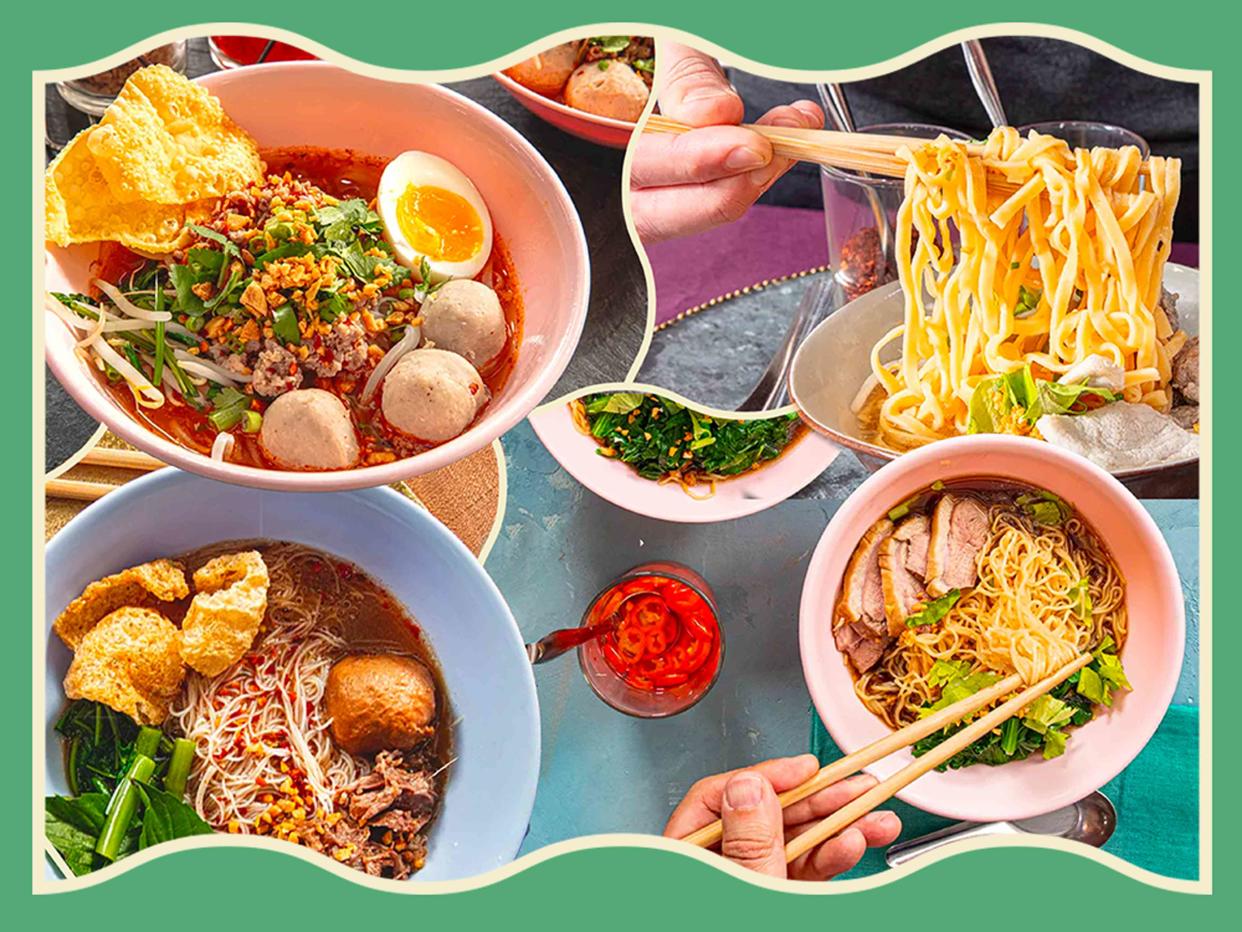
Serious Eats
Look at the menu of many Thai restaurants, and you’ll see many curries, soups, salads, and stir-fries. But compare that with what Thai people typically eat on a regular basis, and you’ll notice that a major food group is underrepresented or missing entirely: noodle soups, called guaydtiaao in Thai (also transliterated as guay tiew among other spellings).
Thai people eat a lot of noodle soups—some even have them daily. In Thailand, you can find noodle soups everywhere, whether at street food stalls or in sit-down restaurants. They’re as common as sandwiches in North America. But why don’t we see more of them on North American restaurant menus? My theory: It’s a logistical issue. The ingredients and set-up required to make noodle soups are unique, and for many restaurants, it simply isn’t practical to add that on top of everything else they make. This is probably why in Thailand, most noodle soup vendors only sell noodle soups, and often only one type of noodle soup. This is also why most Thai people don’t make noodle soups at home.
But it’s possible and worthwhile to make great Thai noodle soups at home, and while I can’t advertise them as a “quick and easy meal,” the actual cooking is extremely low-effort and fast. Order a bowl of noodles in Thailand, and a few minutes is all it takes to assemble. Though the prep takes a while, much of it is hands-off simmering time for the broths. In all honesty, the biggest effort required is the shopping itself, since you will need to visit Asian markets to find several essential ingredients. With a well-stocked Thai pantry and just a little planning, though, you can have a fully-loaded bowl of Thai noodle soup for dinner—even on a weeknight. Here are all the components of any bowl.
Types of Broth
While there are many types of broths for noodle soups, you can divide them into two major types: light and dark.
Light broth is called nam sai, which literally means “clear broth.” It’s basically a pork or chicken stock that has been seasoned with salt, sugar, soy sauce, and/or fish sauce. Other than basic aromatics like daikon, cilantro stems, and white pepper, these broths usually don’t have many herbs or spices.
This basic pork or chicken stock can be used as a base for all kinds of noodle soups, depending on how you choose to customize it. For example, you can add a pink sauce made from Chinese fermented red beancurd and turn it into a noodle soup called yen ta fo, or you can add some lime juice, chile flakes, and roasted peanuts to make a tom yam-style noodle soup (this is different from the famous tom yam soup, which contains lemongrass, galangal, and shrimp).
Dark broths, or nam kon, are more heavily seasoned and get their inky hue from black soy sauce. They’re made with lots of herbs and spices infused into them, which, depending on the recipe, may include cinnamon, star anise, coriander seeds, and galangal. Nam kon often doubles as the braising liquid for the featured protein. For example, if you’re making a duck noodle soup, you would braise the duck in the broth. The same goes for braised beef noodle soup.
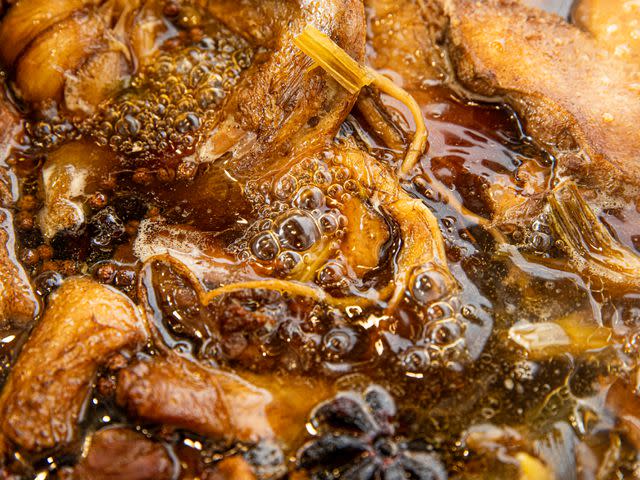
Serious Eats / Amanda Suarez
The majority of noodle soups in Thailand are made with pork stock, and pork is the most common meat used. However, when the featured protein is not pork, the broth is often made to match the meat. For example, a beef noodle soup would typically use beef stock, and a chicken noodle soup would be made with chicken stock. The exception to this rule are fish noodle soups; these are usually made with pork stock, as fish stock would make the dish too fishy.
"Dry" Noodle Soup
As counterintuitive as it sounds, you can also opt to have no soup in your "noodle soup." In Thailand, a “hang” (dry) version is available for any kind of noodle soup. The broth is omitted and the noodles are tossed with the seasonings instead. Everything else—the meat, vegetables, and toppings—remain the same. It’s a nice, light version that’s great for when you want noodles, but not the hot soup
Choose Your Noodle
The fun part about Thai noodle soups is that there’s a lot of room for customization, the major one being your choice of noodles. At minimum, most vendors will have the following four options:
Sen mee - super thin rice vermicelli
Sen lek - rice noodles like ones you get in Vietnamese pho
Sen yai - fresh, wide flat rice noodles similar to ones you find in pad see ew, but for noodle soups they tend to be smaller and more delicate.
Bamee - wonton noodles made from wheat
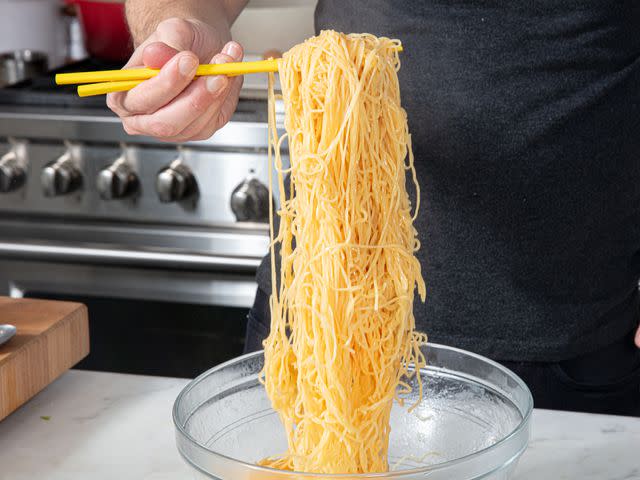
Serious Eats / Amanda Suarez
Besides the basic four, some vendors may also offer:
Sen mama - instant noodles. Mama is a popular brand of Thai instant noodles, and many people use these noodles for cooking as well.
Woon sen - Glass noodles made from mung bean starch.
Common Toppings
Gathering and preparing all the toppings is the most time-consuming part of making Thai noodle soups. While it may be tempting to skip a topping in the interest of speed, it's worth it to make everything the recipe calls for to achieve the complete balance of flavors and textures in the final bowl—without the combination of a protein, some vegetables, herbs, and condiments, it’s really not the same.
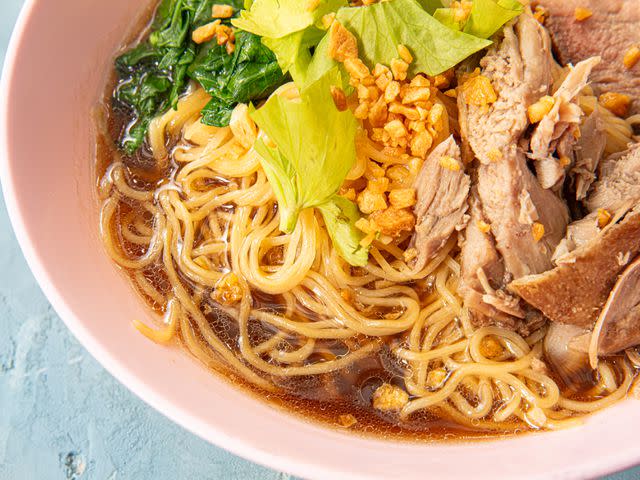
Serious Eats / Amanda Suarez
Proteins
Noodle soups made with light broths are typically served with proteins like Asian meatballs, fish cakes, and wontons, which can all be store-bought. Other popular proteins include ground pork, fish, seafood, thinly sliced meats, and offal; some of the quick-cooking fresh meats are briefly marinated with ingredients like fish sauce before cooking to infuse them with more flavor. All of these are cooked simply by blanching in boiling water or the broth itself.
Dark broth noodles tend to be a bit more involved as they often use meats that have been braised in the broth—it’s like making a stew, then serving it with noodles. Sometimes this isn’t necessary, as in the case of boat noodles, which need just meatballs and sliced meats; although, as you can see in our recipe for boat noodles, you can make a great meat topping from the meats used to flavor the sauce anyway, without almost any extra effort (aside from picking the meat off the bones). Fish and seafood are usually paired with a lighter, more neutral pork broth and are rarely served with dark broths.
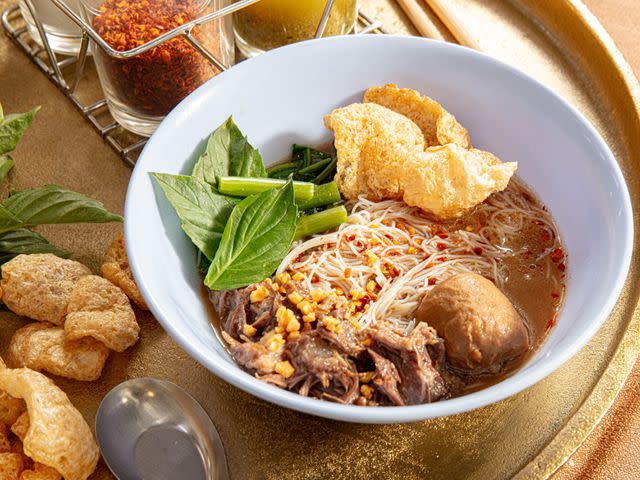
Serious Eats / Amanda Suarez
In addition to meat and fish, tofu is sometimes added to noodle soups. Vegetarian noodle soups, however, are rare in Thailand and only available at a handful of specialty shops.
Noodle vendors offer many different proteins, but at home, I stick with just one or two for simplicity’s sake. If you’re braising something in the dark broth, there’s really no need to add anything else beyond the braised meat itself—but if you really want an additional protein, Asian meatballs are great because they come ready-made.
Vegetables
Mung bean sprouts are almost always added to noodle soups, as they help lighten the meal and bring freshness and a pleasant crunch. Greens like morning glory (water spinach), bok choy, or lettuce are sometimes added, especially with dark broths. Don’t overdo the vegetables, though, as they usually play a minor role in Thai noodle soups.
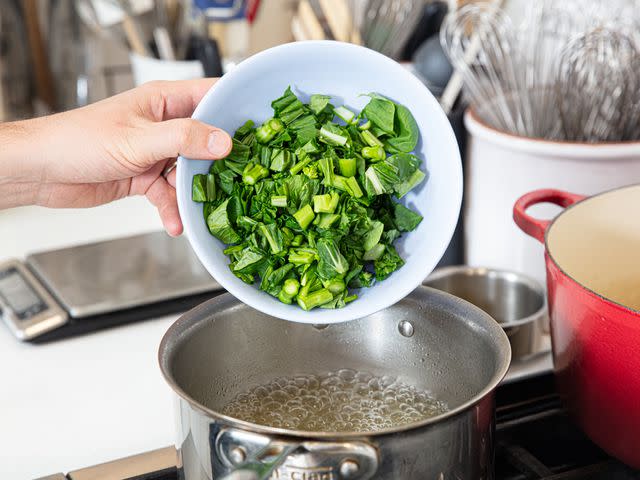
Serious Eats / Amanda Suarez
Fried Garlic and Garlic Oil
This sounds like a fussy final touch that can be skipped, but trust me when I say the fried garlic is not to be missed. Thai noodle soups are almost always topped with fried garlic, and if the place fries their own garlic, you’ll also get a drizzle of garlic oil in the bowl, which is the best part. This is something you should make several days in advance, even in the microwave.
Finishing Herbs
For an element of freshness, Thai noodle soups are finished with fresh herbs like chopped cilantro and green onions. Sometimes vendors may also add sawtooth coriander, also known as culantro, or Thai basil.
Condiments
At noodle soup restaurants in Thailand, diners will find a platter of condiments that includes roasted chile flakes, chile vinegar, sugar, and fish sauce. It’s a complete set of sweet, salty, sour, and spicy, so the diner can taste the soup and then adjust the broth to their liking. At home, the only condiments I put out when serving are chile flakes and chile vinegar, since I can sweeten and flavor the broth with sugar and fish sauce to my liking before serving. That said, if not all of your diners agree on the sweetness and salty-umami levels of the broth, feel free to offer sugar and fish sauce as well, since you will already have them on hand.
Making Noodle Soups at Home
Though it’s certainly possible to make everything from scratch all in one go if you’re most of the day to cooking, I recommend spreading out the work to make it more manageable. The prep list below is based on what Thai noodle soup vendors have to get done in order to assemble noodles in just a few minutes. How much you’d like to prepare in advance is entirely up to you, but checking one or two things off the list below will help streamline things on the day you plan to have your noodles.
Fry your garlic and store the crisped garlic and garlic oil separately.
Any other crispy fried toppings, like fried wonton wrappers, can also be made a day or two ahead and stored in an airtight container.
Make the broth. The broth can be refrigerated for a week or frozen for at least a few months, and if the broth also yields any braised meats, you can pick the meat after braising and save it separately as well.
On the day you plan to finish and serve the noodles, these steps—which you should do more or less in this order—are all that’s left to do.
Marinate fresh proteins. Some fresh toppings for noodle soups, like thinly sliced pork, will get a brief marinade with flavorings like fish sauce and white pepper, just to ensure they're not bland in the bowl.
Prep fresh herbs and vegetables. Wash and trim/pick any fresh herbs and vegetables so they're ready for cooking and/or serving.
Bring a pot of water to a boil for blanching the vegetables and noodles. There’s no need to salt the water, since the soup will be well seasoned enough. And while I know it’s tempting to turn this into a one-pot meal by cooking the noodles in the broth, don’t do it! Noodles release a lot of starch into the cooking water and will turn your broth cloudy.
Reheat the broth by bringing it to a boil.
Cook the proteins in the broth (or, if the recipe instructs, in the blanching water), then scoop them out with a skimmer and set aside. Keep the broth hot on very low heat and cover it with a lid to prevent it from reducing.
Blanch the vegetables. Once your water is boiling, cook the vegetables until just wilted, then divide among the serving bowls.
Cook the noodles and divide among the serving bowls. The noodles should be the last thing you cook as the water will become starchy after that. You can then toss the noodles in the garlic oil, which prevents them from sticking and flavors the bowl.
Top the noodles with the protein, fried garlic, additional garlic oil, and finishing herbs.
Ladle the broth over the noodles when ready to eat and serve immediately.
Read the original article on Serious Eats.

